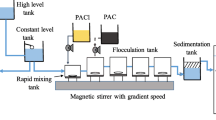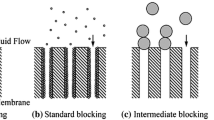Abstract
We investigated the fouling performances of ultrafiltration (UF) membrane for treating in-line coagulated water in an enhanced coagulation-UF hybrid process. Then we analyzed the fouling mechanisms in the early stage of UF using mathematical models and microscopy observation methods. Finally, we discussed the impact of aeration on membrane fouling in this paper. The results showed that a two-stage of trans-membrane pressure (TMP) profile during the operation of enhanced coagulation-UF membrane was observed, and the relationship between permeability and operation time fitted well with a logarithmic curve. Membrane pores blocking and cake filtration were confirmed as main membrane fouling mechanisms using the mathematical models. The two stages of membrane fouling mechanisms were further deduced, namely, the membrane pore narrowing followed by the formation of cake layer. Membrane autopsy analysis using scanning electron microscopy (SEM) images of the membrane surface sampled from different filtration cycles also confirmed the mechanisms of pores blocking and cake filtration. Moreover, according to the variations of the permeability and membrane fouling resistance, aeration was able to mitigate and control the membrane fouling to a certain extent, but the optimization of aeration conditions still needs to be studied.
Similar content being viewed by others
References
Shannon M A, Bohn P W, Elimelech M, Georgiadis J G, Mariñas B J, Mayes A M. Science and technology for water purification in the coming decades. Nature, 2008, 452(7185): 301–310
Hoek E M V, Bhattacharjee S, Elimelech M. Effect of membrane surface roughness on colloid-membrane DLVO interactions. Langmuir, 2003, 19(11): 4836–4847
Costa A R, de Pinho M N, Elimelech M. Mechanisms of colloidal natural organic matter fouling in ultrafiltration. Journal of Membrane Science, 2006, 281(1–2): 716–725
Lawrence N D, Perera J M, Iyer M, Hickey MW, Stevens GW. The use of streaming potential measurements to study the fouling and cleaning of ultrafiltration membranes. Separation and Purification Technology, 2006, 48(2): 106–112
Yamamura H, Kimura K, Okajima T, Tokumoto H, Watanabe Y. Affinity of functional groups for membrane surfaces: implications for physically irreversible fouling. Environmental Science & Technology, 2008, 42(14): 5310–5315
Lee E K, Chen V, Fane A G. Natural organic matter (NOM) fouling in low pressure membrane filtration — effect of membranes and operation modes. Desalination, 2008, 218(1–3): 257–270
Howe K J, Clark M M. Fouling of microfiltration and ultrafiltration membranes by natural waters. Environmental Science & Technology, 2002, 36(16): 3571–3576
Lee N H, Amy G, Croué J P, Buisson H. Identification and understanding of fouling in low-pressure membrane (MF/UF) filtration by natural organic matter (NOM). Water Research, 2004, 38(20): 4511–4523
Brinck J, Jonsson A S, Jonsson B, Lindau J. Influence of pH on the adsorptive fouling of ultrafiltration membranes by fatty acid. Journal of Membrane Science, 2000, 164(1–2): 187–194
Lee S, Cho J W, Elimelech M. Combined influence of natural organic matter (NOM) and colloidal particles on nanofiltration membrane fouling. Journal of Membrane Science, 2005, 262(1–2): 27–41
Hong S K, Elimelech M. Chemical and physical aspects of natural organic matter (NOM) fouling of nanofiltration membranes. Journal of Membrane Science, 1997, 132(2): 159–181
Lee J D, Lee S H, Jo M H, Park P K, Lee C H, Kwak J W. Effect of coagulation conditions on membrane filtration characteristics in coagulation-microfiltration process for water treatment. Environmental Science & Technology, 2000, 34(17): 3780–3788
Fan L H, Harris J L, Roddick F A, Booker N A. Influence of the characteristics of natural organic matter on the fouling of microfiltration membranes. Water Research, 2001, 35(18): 4455–4463
Kang S K, Choo K H. Why does a mineral oxide adsorbent control fouling better than powdered activated carbon in hybrid ultrafiltration water treatment? Journal of Membrane Science, 2010, 355(1–2): 69–77
Crozes G, Jacangelo J, Anselme C, Laine J. Impact of ultrafiltration operating conditions on membrane irreversible fouling. Journal of Membrane Science, 1997, 124(1): 63–76
Zsirai T, Buzatu P, Aerts P, Judd S. Efficacy of relaxation, backflushing, chemical cleaning and clogging removal for an immersed hollow fibre membrane bioreactor. Water Research, 2012, 46(14): 4499–4507
Yamamura H, Chae S, Kimura K, Watanabe Y. Transition in fouling mechanism in microfiltration of a surface water. Water Research, 2007, 41(17): 3812–3822
Lee N, Amy G, Croue J P, Buisson H. Morphological analyses of natural organic matter (NOM) fouling of low-pressure membranes (MF/UF). Journal of Membrane Science, 2005, 261(1–2): 7–16
Wang J, Wang X C. Ultrafiltration with in-line coagulation for the removal of natural humic acid and membrane fouling mechanism. Journal of Environmental Sciences-China, 2006, 18(5): 880–884
Grenier A, Meireles M, Aimar P, Carvin P. Analysing flux decline in dead-end filtration. Chemical Engineering Research & Design, 2008, 86(11 11A): 1281–1293
Wang F L, Tarabara V V. Pore blocking mechanisms during early stages of membrane fouling by colloids. Journal of Colloid and Interface Science, 2008, 328(2): 464–469
Chu H, Dong B, Zhang Y, Zhou X, Yu Z. Pollutant removal mechanisms in a bio-diatomite dynamic membrane reactor for micro-polluted surface water purification. Desalination, 2012, 293: 38–45
Huang H, Schwab K, Jacangelo J G. Pretreatment for low pressure membranes in water treatment: a review. Environmental Science & Technology, 2009, 43(9): 3011–3019
Barbot E, Moustier S, Bottero J Y, Moulin P. Coagulation and ultrafiltration: understanding of the key parameters of the hybrid process. Journal of Membrane Science, 2008, 325(2): 520–527
Howe K J, Marwah A, Chiu K P, Adham S S. Effect of coagulation on the size of MF and UF membrane foulants. Environmental Science & Technology, 2006, 40(24): 7908–7913
Park P K, Lee C H, Choi S J, Choo K H, Kim S H, Yoon C H. Effect of the removal of DOMs on the performance of a coagulation-UF membrane system for drinking water production. Desalination, 2002, 145(1–3): 237–245
Pikkarainen A T, Judd S J, Jokela J, Gillberg L. Pre-coagulation for microfiltration of an upland surface water. Water Research, 2004, 38(2): 455–465
Best G, Singh M, Mourato D, Chang Y J. Application of immersed ultrafiltration membranes for organic removal and disinfection byproduct reduction. Water Supply, 2001, 1(5–6): 221–231
Sun L H, Li X, Xia S J, Lü M, Li G B. Pilot study of potassium permanganate enhancing Songhua River water treatment by coagulation/sand filtration /ultrafiltration process. Membrane Science and Technology, 2008, 28(01): 77–80
Liang H, Yang Y L, Gong W J, Li X, Li G B. Effect of pretreatment by permanganate/chlorine on algae fouling control for ultrafiltration (UF) membrane system. Desalination, 2008, 222(1–3): 74–80
Zheng X, Ernst M, Jekel M. Identification and quantification of major organic foulants in treated domestic wastewater affecting filterability in dead-end ultrafiltration. Water Research, 2009, 43(1): 238–244
USEPA. Membrane Filtration Guidance Manual. Ohio: United States Environmental Protection Agency, Office of Water, 2005
Lin C F, Lin Y C, Chandana P S, Tsai C Y. Effects of mass retention of dissolved organic matter and membrane pore size on membrane fouling and flux decline. Water Research, 2009, 43(2): 389–394
Author information
Authors and Affiliations
Corresponding author
Rights and permissions
About this article
Cite this article
Chang, H., Liu, B., Luo, W. et al. Fouling mechanisms in the early stage of an enhanced coagulation-ultrafiltration process. Front. Environ. Sci. Eng. 9, 73–83 (2015). https://doi.org/10.1007/s11783-014-0692-7
Received:
Accepted:
Published:
Issue Date:
DOI: https://doi.org/10.1007/s11783-014-0692-7




